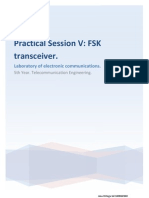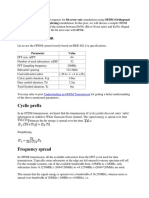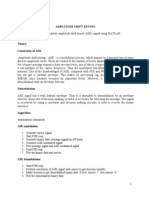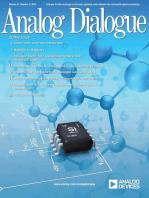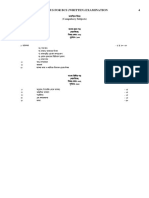Phase Modulation Report With Code
Uploaded by
thirupathibadavath1918Phase Modulation Report With Code
Uploaded by
thirupathibadavath1918Phase Modulation and Demodulation Using MATLAB with Code Explanation
1. Introduction
- Overview of phase modulation (PM) as a method of transmitting a message signal.
- Explanation of the key objective: to modulate and demodulate an audio signal using MATLAB.
2. Experimental Setup and Parameters
- Define constants and parameters such as sampling frequency (Fs), carrier frequency (fc), and
modulation index (beta).
- Briefly describe the purpose of each parameter in the modulation and demodulation process.
3. Audio Recording and Preprocessing
- Recording the Audio Signal: Explanation of how MATLAB's audiorecorder function is used to
capture a 20-second audio sample.
- Saving and Loading Audio Data: Storing the recorded audio as a .wav file and reloading it for
processing.
4. MATLAB Code Explanation - Line-by-Line
- Fs = 200000; # Sampling frequency of 200 kHz.
- recObj = audiorecorder(Fs, 16, 1); # Creates an audio recorder with 16-bit resolution and mono
channel.
- disp('Start speaking for 20 seconds.'); # Prompts user to start speaking.
- recordblocking(recObj, 20); # Records audio for 20 seconds.
- disp('End of recording.'); # Signals end of recording.
- messageSignal = getaudiodata(recObj); # Extracts the audio data.
- audiowrite('message_signal.wav', messageSignal, Fs); # Saves the audio as a WAV file.
- disp('Audio saved as message_signal.wav'); # Confirms the audio has been saved.
- [messageSignal, Fs] = audioread('message_signal.wav'); # Loads the saved audio file.
- sound(messageSignal, Fs); # Plays back the recorded audio.
- fc = 50000; # Carrier frequency set to 50 kHz.
- fs = Fs; # Sets the sampling frequency to match the audio file.
- beta = 10; # Modulation index for phase modulation.
- t = (0:length(messageSignal)-1) / fs; # Generates time vector based on message length.
- s = cos(2 * pi * fc * t + beta * messageSignal'); # Generates PM signal by phase-shifting the
carrier.
- analytic_signal = hilbert(s); # Computes the analytic signal using Hilbert transform.
- instantaneous_phase = unwrap(angle(analytic_signal)); # Unwraps the phase to avoid
discontinuities.
- phase_derivative = [0, diff(instantaneous_phase) * fs]; # Differentiates phase for message
recovery.
- phase_derivative_without_carrier = phase_derivative - 2 * pi * fc; # Removes carrier component.
- recovered_message = cumtrapz(t, phase_derivative_without_carrier) / beta; # Integrates to
recover message.
- recovered_message = recovered_message - mean(recovered_message); # Removes DC
component.
- demodulated_signal = recovered_message; # Assigns final demodulated message signal.
5. Visualization of Signals
- Time-Domain Plots: Displays original, modulated, and demodulated signals.
- Frequency-Domain Analysis: FFT of original and modulated signals to examine frequency
components.
6. Adding Noise and Signal Analysis
- Adding AWGN Noise: Simulates real-world noise at 20 dBm and 30 dBm levels.
- Demodulation with Noise: Evaluates how added noise impacts the fidelity of demodulation.
7. Results and Observations
- Compares original and demodulated message signals, showing effectiveness of the method.
- Discusses noise effects, demonstrating robustness or limitations of this PM method in noisy
environments.
8. Conclusion
- Summarizes findings on PM signal recovery and recommendations for noise-handling
improvements.
You might also like
- Experiment No.: 01 Name of The Experiment: DSB-SC Modulation Using MATLAB CodingNo ratings yetExperiment No.: 01 Name of The Experiment: DSB-SC Modulation Using MATLAB Coding4 pages
- 21BEC1676 Avinash V Analog Communiction EXP 4No ratings yet21BEC1676 Avinash V Analog Communiction EXP 46 pages
- 21BEC1676 Avinash V Analog Communiction EXP 5No ratings yet21BEC1676 Avinash V Analog Communiction EXP 56 pages
- EEE 352 Analog Communication Systems Bet V A/B Assignment II DSBSC Modulation in MATLABNo ratings yetEEE 352 Analog Communication Systems Bet V A/B Assignment II DSBSC Modulation in MATLAB2 pages
- ECS 701 Communication Theory Lab Session: Wireless Communication Systems Simulation Using MATLABNo ratings yetECS 701 Communication Theory Lab Session: Wireless Communication Systems Simulation Using MATLAB13 pages
- NAME-Aditya Bhura SCHOLAR ID - 1914033 Ece-A Experiment-3 TITLE/AIM OF THE EXPERIMENT: DSBSC Modulation and Demodulation Software Used:Matlab TheoryNo ratings yetNAME-Aditya Bhura SCHOLAR ID - 1914033 Ece-A Experiment-3 TITLE/AIM OF THE EXPERIMENT: DSBSC Modulation and Demodulation Software Used:Matlab Theory9 pages
- Practical Session V: FSK Transceiver.: Laboratory of Electronic CommunicationsNo ratings yetPractical Session V: FSK Transceiver.: Laboratory of Electronic Communications11 pages
- ADC Lab 12 Open Ended Problem_22i1433_CNo ratings yetADC Lab 12 Open Ended Problem_22i1433_C10 pages
- Experiment 4 - Frequency Modulation Using Scilab0% (1)Experiment 4 - Frequency Modulation Using Scilab6 pages
- Communications Technology Lab 2: Modulation (AM and FM) Using MatlabNo ratings yetCommunications Technology Lab 2: Modulation (AM and FM) Using Matlab2 pages
- Matlab: Am and FM Modulation: Experiment NumberNo ratings yetMatlab: Am and FM Modulation: Experiment Number2 pages
- Digital Communication Systems: Name:D.V.Sahithi REGNO:18BEC2011 SLOT:L29+L30 Faculty:Prof - Velmuragn.TNo ratings yetDigital Communication Systems: Name:D.V.Sahithi REGNO:18BEC2011 SLOT:L29+L30 Faculty:Prof - Velmuragn.T12 pages
- Introduction To Communication System Chapter Two Analog Modulation Techniques100% (2)Introduction To Communication System Chapter Two Analog Modulation Techniques47 pages
- Miniproject Communicationlinksimulation Digitalmodulationtechniqueslecture 100215034826 Phpapp010% (2)Miniproject Communicationlinksimulation Digitalmodulationtechniqueslecture 100215034826 Phpapp0133 pages
- OFDM Modulation: Frequency Division Multiplexing) Modulation. in This Post, We Will Discuss A Simple OFDMNo ratings yetOFDM Modulation: Frequency Division Multiplexing) Modulation. in This Post, We Will Discuss A Simple OFDM7 pages
- Wireless Access Systems Exercise Sheet 2: Coded OFDM Modem: Oals of The XerciseNo ratings yetWireless Access Systems Exercise Sheet 2: Coded OFDM Modem: Oals of The Xercise6 pages
- SHORTREPORT - G601 - Amplitude ModulationNo ratings yetSHORTREPORT - G601 - Amplitude Modulation33 pages
- Introduction To Digital Data TransmissionNo ratings yetIntroduction To Digital Data Transmission66 pages
- Experiment No.: 03 Name of The Experiment: MATLAB Code of Product Detection of DSB-SC Demodulation ObjectiveNo ratings yetExperiment No.: 03 Name of The Experiment: MATLAB Code of Product Detection of DSB-SC Demodulation Objective5 pages
- ECL 332 Communication Lab Manual Part ANo ratings yetECL 332 Communication Lab Manual Part A12 pages
- Chapter 5 Introduction To Digital Data Transmission PDFNo ratings yetChapter 5 Introduction To Digital Data Transmission PDF66 pages
- ES442 Lab 6 Frequency Modulation and Demodulation: ObjectiveNo ratings yetES442 Lab 6 Frequency Modulation and Demodulation: Objective6 pages
- Radio Frequency Identification and Sensors: From RFID to Chipless RFIDFrom EverandRadio Frequency Identification and Sensors: From RFID to Chipless RFIDNo ratings yet
- Some Case Studies on Signal, Audio and Image Processing Using MatlabFrom EverandSome Case Studies on Signal, Audio and Image Processing Using MatlabNo ratings yet
- Instructions - Fortigate Cli Reference Mr6100% (5)Instructions - Fortigate Cli Reference Mr614 pages
- Syllabus For Bcs (Written) Examination: (Compulsory Subjects)No ratings yetSyllabus For Bcs (Written) Examination: (Compulsory Subjects)11 pages
- Factura/Invoice: Ap.51, Focsani, VranceaNo ratings yetFactura/Invoice: Ap.51, Focsani, Vrancea1 page
- Professional Teacher - Secondary (Social Studies)No ratings yetProfessional Teacher - Secondary (Social Studies)64 pages
- Dharmendra Kumar Dubey: Academic ProfileNo ratings yetDharmendra Kumar Dubey: Academic Profile3 pages
- Derrick/Mast Inspection Certificate: (API Recommended Practice 4G - 3 Edition 2004 - Sect 9.0)No ratings yetDerrick/Mast Inspection Certificate: (API Recommended Practice 4G - 3 Edition 2004 - Sect 9.0)1 page
- 3.3 Characteristics of Polynomial Functions in Factored FormNo ratings yet3.3 Characteristics of Polynomial Functions in Factored Form3 pages
- Chapter 1. Introduction To Machine VisionNo ratings yetChapter 1. Introduction To Machine Vision167 pages
- Visual Studio - Why Am I Getting - Cannot Connect To Server - A Network-Related or Instance-Specific Error - Stack OverflowNo ratings yetVisual Studio - Why Am I Getting - Cannot Connect To Server - A Network-Related or Instance-Specific Error - Stack Overflow25 pages
- White Paper Interconnect Solutions Debugging Issues Advanced ARM CoreLinkNo ratings yetWhite Paper Interconnect Solutions Debugging Issues Advanced ARM CoreLink8 pages
- AI_LOGBOOK_ASSISTANT_(1)[1](3) final doneNo ratings yetAI_LOGBOOK_ASSISTANT_(1)[1](3) final done25 pages























